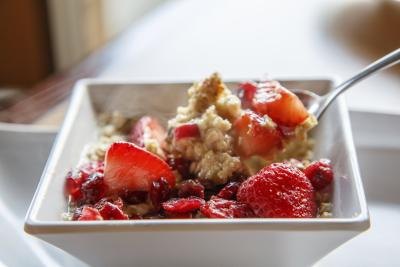Oatmeal is a healthy addition to a nutritious, well-balanced diet plan that consists of complex carbs, lean proteins and healthy fats. As part of a low-calorie diet, oatmeal may assist in weight-loss efforts in addition to maintaining a healthy digestive system. Fiber in oatmeal aids in moving waste products through the digestive tract for elimination, preventing upsets such as constipation, bloating and flatulence. Although most commonly enjoyed as a breakfast food, oatmeal can also be eaten as a light lunch meal or as a snack throughout the day. Consult with a physician prior to making any dietary changes such as eating oatmeal for lunch daily to ensure individual nutritional needs are met.

Step 1
Pour the appropriate serving size of oatmeal for a lunch that is moderate in calories. Serving sizes will vary depending on your individual needs such as physical activity levels and weight-loss goals, in addition to height, weight and gender. According to Every Diet.com, a variation of the Oatmeal Diet recommends eating 1/2 a cup of oatmeal for lunch with other foods to round out the meal. Look at package labels and nutritional information to determine the amount of calories in one serving size.
Step 2
Mix oatmeal with water or low-fat milk. Water provides no additional calories to oatmeal but serves to thicken it up for a creamy or chewy consistency so it can be eaten as a hot or cold cereal. Use hot, boiling water if you desire a hot cereal. Or simply add cold water and microwave on high for 1 to 2 minutes. The amount of water you use will depend on your serving size and desired texture. Generally, 1/2 cup of oatmeal will require 1 cup of water or other liquid. Replacing water with low-fat milk will add extra protein, calories and flavor to your meal.
Step 3
Add fresh fruit to your oatmeal bowl. Oatmeal is a source of complex carbs that provide energy to the body and brain for essential physical and mental tasks. However, adding other ingredients will provide other essential nutrients as well as make your lunch meal more filling. In particular, fresh fruit such as berries and chopped bananas add essential vitamins, minerals and antioxidants to your meal that protect against certain health diseases and cancers. Add 1/2 to 1 cup of berries such as blueberries and raspberries with 1/2 a sliced banana.
Step 4
Sprinkle nuts on top of your oatmeal. Nuts are a source of healthy fats that are essential for normal body functions, hormonal development and the absorption of vitamins. Since oatmeal is a low-fat whole-grain, adding healthy fats will increase the meal's satiation factor to fill you up and prevent hunger cravings shortly after eating. Add chopped or slivered nuts to your oatmeal such as almonds, walnuts, pecans or cashews. Alternatively, try stirring in 1 tbsp. of peanut butter or almond butter that is all-natural and sugar-free.
www.livestrong.com





No comments:
Post a Comment